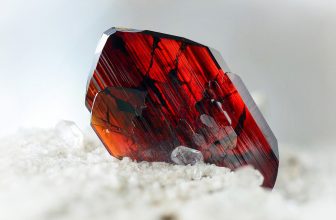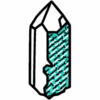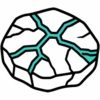Tabular Crystals
 Nature’s Thin Messengers of Light
Nature’s Thin Messengers of Light
Imagine holding a crystal so thin and wide that light doesn’t just shine on it – it moves through it. The surface gleams like a glassy lake under morning sun, rippling with reflections that seem almost alive.
What makes some crystals grow this way – spreading outward in sheets rather than rising in towers? Why does nature sometimes choose elegance over elevation?
These are the quiet wonders of Tabular Crystals, affectionately known as “Tabby Crystals.” Their form is unmistakable: broad, flat faces, sometimes paper-thin, that resemble nature’s own tablets. The term “tabular” comes from the Latin tabula, meaning “table” or “slab,” hinting at their wide, flattened geometry. “Tabby” is the name crystal lovers use when speaking of them as companions rather than specimens – approachable, radiant, and full of subtle energy.
The Art of Balanced Growth
How does nature sculpt something so thin, so perfectly proportioned, without breaking its own rules? The secret lies in directional restraint – the dance of chemistry and circumstance that governs how crystals grow.
In a mineral-rich environment, atoms attach themselves to certain planes of a forming crystal. Under usual conditions, this growth is fairly uniform, creating well-proportioned shapes like prisms or hexagons. But sometimes, environmental forces – temperature, pressure, or the presence of other minerals – slow growth along one axis while allowing it to continue freely along another.
The result? A crystal that spreads outward like a sheet of light rather than upward like a tower. This selective expansion creates the wide, plate-like geometry characteristic of tabular formation.
Each layer tells a story. In some, you can see fine striations – delicate grooves formed as new layers were added. Others reveal step-like ridges or transparent zones where light bends and dances. The smooth, mirror-like faces aren’t just beautiful; they’re geological records of precise balance between restriction and freedom, tension and release.
The Crystals That Take the Tabular Form
When nature chooses to express itself in sheets rather than spires, the result can appear in a surprising range of minerals – each one telling its own version of the tabular story.
Barite often leads the list. Heavy in the hand yet airy in appearance, its pale honey or sky-blue plates seem to hover just above the matrix they grew from. Their broad surfaces can look almost metallic, reflecting light like ancient glass.
Then there’s Gypsum, especially in its clear variety known as Selenite. These tabular crystals cleave into perfect, luminous sheets that catch and bend light in soft ripples. Selenite’s delicate transparency makes it a favorite for anyone drawn to purity and gentle illumination.
Calcite, another master of form, grows into thick, tabular plates that gleam with golden or icy clarity. Their optical properties are famous – double refraction means that light entering the crystal splits in two, a visual metaphor for its ability to reveal more than one truth at once.
Beryl species, including Aquamarine, sometimes grow in flattened prisms rather than the usual tall columns. These forms feel like the ocean pressed into stone – serene, still, and reflective.
Even Tourmaline and Quartz occasionally adopt this unusual structure. Tabular Quartz, often double-terminated, carries a reputation as a crystal of communication and alignment – transmitting energy smoothly across its wide surface like a polished bridge between realms.
Collectors often notice that tabular crystals amplify light play – their surfaces reflecting, refracting, and diffusing illumination in mesmerizing ways. It’s as if the crystal itself prefers to spread radiance evenly, mirroring the same balance it was born from.
When Form Mirrors Function
Hold a tabular crystal in your hand, and you’ll immediately feel its difference. It doesn’t rise or point; it rests. The shape feels deliberate – a geometry that chooses breadth over height, peace over ambition.
Most are rectangular, hexagonal, or occasionally oval, with flat, smooth faces and razor-thin edges that shimmer when the light hits just right. Run your fingers across the surface, and you’ll sense a quiet stability – like touching a still pond just before dawn.
This geometry affects more than appearance; it also changes the way light behaves. Tabular crystals act like miniature mirrors or windows. Their internal clarity can reveal layers, veils, or rainbows – optical whispers of the journey they’ve taken underground.
Because of their broad structure, these crystals tend to balance rather than focus energy. Where a prismatic crystal directs energy like an arrow, a tabular one spreads it evenly across a plane. In this sense, their physical form perfectly mirrors their energetic function – creating harmony, equalizing flow, and inviting stillness in the midst of motion.
In collections or crystal grids, they often serve as stabilizing anchors – grounding the energy of more pointed or directional stones. They remind the entire arrangement that connection requires spaciousness.
The Energy of Connection and Clarity
If you’ve ever felt torn between too many thoughts or emotions, a tabular crystal might be the quiet ally you didn’t know you needed. These stones are often described as “communication crystals” – not because they make you talk more, but because they help you listen better.
Their wide, flat surfaces symbolize clarity and exchange. They’re believed to create energetic bridges – between people, between the conscious and subconscious mind, or between physical and spiritual understanding. When you meditate with one, it’s as though your inner dialogue slows just enough for insight to slip through.
Emotionally, tabular crystals bring harmony between extremes: logic and intuition, groundedness and expansion. They teach balance without suppression – showing how strength can coexist with softness.
Energetically, they facilitate transmission. Healers often place them between two points to carry or balance energy flow. Because they don’t concentrate energy into a beam, they prevent overwhelm, allowing transformation to unfold gently and evenly.
Different minerals amplify this theme in their own voices:
- Tabular Quartz – aligns chakras, encourages transparency in communication.
- Tabular Selenite – cleanses, resets, and keeps other crystals energetically clear.
- Tabular Barite – strengthens the connection between physical reality and higher awareness.
Symbolically, they remind us that power doesn’t always rise – sometimes it extends outward, touching more space, more softly. Tabular crystals whisper a truth our world often forgets: balance isn’t found in reaching higher, but in widening our capacity for connection.

 Nature’s Thin Messengers of Light
Nature’s Thin Messengers of Light




















